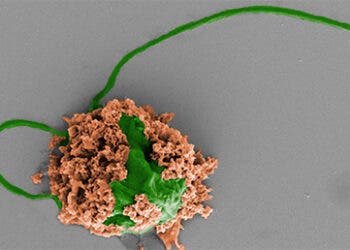
For nine days in May 2024, a lung from a pig lived inside the chest of a man in Guangzhou, China.
The patient, a 39-year-old declared brain-dead after a brain hemorrhage, thus became the first human recipient of a pig lung. Surgeons at the First Affiliated Hospital of Guangzhou Medical University transplanted the genetically modified organ into him, then watched closely as it clung to viability.
It did not last. Within hours, the lung began swelling. Within days, it showed signs of immune rejection. By day nine, the experiment ended, and the man’s family allowed him to pass away. But the very fact that the lung functioned at all, without immediate catastrophic failure, is something many scientists once thought impossible.
The achievement adds to a growing list of pig-to-human organ transplants, including pig livers, kidneys, and even hearts. Out of all mammals, a pig’s organs are the most compatible with those of humans in terms of size and metabolism. Scientists hope that one day, xenotransplantation (the process of implanting organs, tissues, or cells from one species into another) will address the critical shortage of human organs, with thousands of people to dying on waiting lists each year.
Why Lungs Are the Hardest Organ to Transplant

A New Hampshire man has lived over 7 months (and counting) with a pig kidney from eGenesis, and a Maryland man survived 2 months with a pig heart before dying of complications in 2022. But lungs have long been the toughest challenge in xenotransplantation.
“Every breath you breathe in is bringing the external environment into the body,” Andrew Fisher, a professor of respiratory transplant medicine at Newcastle University who was not involved in the new study, told The Guardian. That constant exposure means the lungs are patrolled by vigilant immune cells, ready to repel invaders. In the context of organ transplantation, that defense becomes a liability.
Even in human-to-human transplants, lungs fail more often than any other solid organ. A healthy kidney may last over a decade. A transplanted lung often survives just five to seven years.
For a pig lung to function inside a human body at all, even briefly, required years of preparation.
The Experiment

The donor was a Bama miniature pig, bred with six specific gene edits. They removed three pig genes (GGTA1, B4GALNT2, CMAH) because they produce molecules that human immune systems attack. And researchers inserted three human genes (CD46, CD55, thrombomodulin) to help shield the organ from rejection.
The surgical team, led by thoracic surgeon Jianxing He, connected the pig’s left lung to the man’s airways and blood vessels. The recipient’s right lung remained intact, ensuring he remained physiologically stable.
At first, the results looked promising. There was no “hyperacute rejection” — the violent, minutes-long immune assault that doomed earlier cross-species transplants. The pig lung drew blood, exchanged gases, and stayed pink.
But 24 hours later, CT scans revealed severe edema, a hallmark of what doctors call primary graft dysfunction. The tissue grew waterlogged and dense, inflamed by the trauma of blood rushing back through its vessels.
By day three, antibodies were binding to the lung, attacking its delicate alveoli. Damage worsened on day six. By day nine, there were faint signs of recovery, but the trial had run its course. The researchers are cautiously optimistic about these results.
“This work is very welcome in furthering our understanding, but it marks an incremental step forward,” said Fisher. “There is much more work required and we are not on the dawn of an era of lung xenotransplantation using pig lungs.”
The Chinese team acknowledged as much in their Nature Medicine paper: “Continued efforts are needed to optimize immunosuppressive regimens, refine genetic modifications, enhance lung preservation strategies and assess long-term graft function beyond the acute phase.”
“Nobody would sign up for a nine-day lung transplant,” said Dr. Adam Griesemer, a transplant surgeon a senior member of the xenotransplantation team for NYU Langone’s Transplant Institute, who was not involved with the new research.
A Wider Race and the Path Forward
The study joins a flurry of recent xenotransplantation milestones, which many patients have been following with great anticipation. The global demand is immense. According to the World Health Organization, only about 10 percent of patients who need an organ transplant ever receive one. In the United States, more than 100,000 people are waiting. Many die before their turn comes.
Dialysis can sustain kidney patients. Mechanical pumps can assist failing hearts. But there is no equivalent for damaged lungs. For people with end-stage lung disease, transplantation is the only hope.
“If there is a way to actually source organs from animals and have them work in genetically modified ways, that would be very exciting,” said Dr. Stephanie Chang, a lung transplant surgeon at NYU Grossman School of Medicine. “There’s not much that can replace your lungs.
The Guangzhou team’s pig lung never carried the full burden of sustaining a body. Critics noted that researchers could have tested its standalone function by clamping off the patient’s native lung but chose not to.
Still, the study offered key insights.
At the Edge of Science
This study showed that with the right genetic modifications and an aggressive cocktail of drugs — including tacrolimus, belatacept, rituximab, and even the complement-blocking drug eculizumab — surgeons can prevent the immediate, catastrophic rejection once thought inevitable when introducing an organ from a foreign species into the human body.
But the lung’s constant exposure to pathogens and pollutants makes long-term success harder. Preventing fluid buildup, antibody attack, and infection will require more genetic engineering — possibly adding anti-inflammatory or anticoagulant genes.
Researchers are also exploring other avenues like repairing damaged human lungs with stem cells. They are even considering growing humanized lungs inside pigs and sheep. Those approaches may bypass some of the immune hurdles inherent in xenotransplantation.
For now, the pig lung transplant sits at the edge of science: neither failure nor triumph, but a crucial foothold on a steep climb. It revealed that a pig lung can live inside a human chest for nine days. The next question is whether it can breathe for someone who needs it most.






